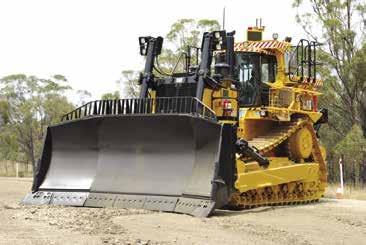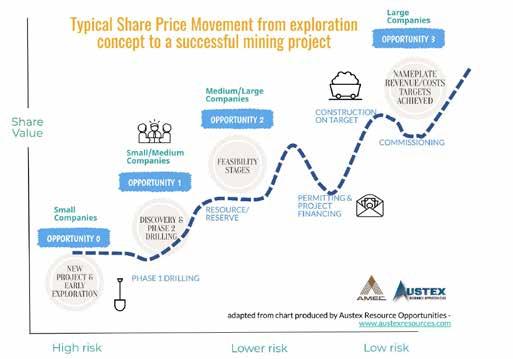
5 minute read
How Governments can play their part in improving the lifecycle of a mineral discovery
from BBMC Yearbook 2020
by bbminingclub
Kate Dickson, Queensland Manager, Association of Mining and Exploration Companies
State and Federal Governments enjoy significant benefits from all the stages of the resources industry. This has been made clear, particularly during COVID-19 where exploration and mining could continue to operate safely, effectively, and with low and manageable risks and away from major population areas.
In order to at least maintain or improve resource project development speed and reduce costs, there are some easy levers Governments can pull to help, such as:
1. Support industry initiatives
2. Infrastructure investment
3. Policy and regulatory stability
Before we jump into what governments can do, let’s look at mineral project development and company value throughout these stages. Over the page, the chart adapted from Austex’s ‘Typical share price movement as project status changes’ represents the life stages of a junior mining or exploration company through different development phases. The Y-axis represents the company value throughout the various stages and the X-axis timeline is dependent on factors like the deposit type and the jurisdiction the project is in, with the jurisdiction often impacting the approval timeframes for projects. Ideally, companies want to spend the least amount of time in the low value sections of the chart.

So, how can Governments help with this necessary part of the process? Policy, grants and strategic infrastructure can assist resource projects when ‘traditional’ funding and valuations make project development difficult. But we’ll dig into this further later.
The main areas where projects struggle, are at the ‘New Project and early exploration’, ‘Feasibility’ and ‘Permitting and project financing’ stages. State and Federal Governments are seeing the benefits of the exploration industry to the economy considering the recent announcements about the industry’s contributions to COVID-19 economic recovery. Most of the announcements have been to assist companies at the Pre-discovery stage. But there are levers within Governments’ control that can improve the success rate for projects struggling through the ‘Feasibility’ and ‘Permitting and project financing’ stages.
1. Support Industry Initiatives
Grants are by far the easiest and quickest ways to get companies on the ground doing exploration. This helps companies in the ‘New project and early exploration’ stage. The Collaborative Drilling Initiative (CDI) in Queensland has been very successful, with recent rounds being significantly over-subscribed. Part of the reason the
Queensland model is so popular is because it’s a full grant, not matched funding like similar programs in other jurisdictions in Australia. A possible way to make this great program even better would be for the companies to be given the money up front. The current process requires the explorer to spend their own money and then get reimbursed.
Another benefit of injecting money into exploration phase is that a small amount at this riskier end of the process can have significant multiplier benefits for a successful project. From an investor perspective (any investor, be it private or government through a grant), a comparatively small investment at the early stages can make all the difference.
The successful CDI model could be expanded to innovation and collaboration between industry and the environmental regulator. A Collaborative Rehabilitation Initiative (CRI) would be welcomed by industry as it would reduce the time and cost associated with trialling new rehabilitation techniques and improve knowledge and outcomes for rehabilitation projects.
2. Infrastructure Investment
Once a resource is found, the next most difficult stages are ‘Feasibility’ and ‘Permitting and project financing’. It is in these stages that strategic infrastructure can help projects increase their value and source investment more quickly and much easier. There are areas in parts of Queensland where there are substantial hurdles for potential projects to overcome. These include:
• Transport and logistics - Many projects are significant distances from the coast (and therefore ports) and accessing high efficiency and low cost logistics infrastructure is too prohibitive for small, emerging projects on a ‘stand-alone’ basis. The Bowen Basin Coal Infrastructure was developed with State Government assistance. The emerging minerals regions need this type of vision and planning to see similar and significant ongoing benefits to the State.
• Electricity Costs - High energy costs and access to energy are key concerns for emerging minerals projects in regional areas like the North West Minerals Province, and with the region’s energy prices being amongst the highest in Queensland, projects like CopperString 2.0 will benefit both existing and emerging producers. The CopperString 2.0 high voltage transmission line to the North West Minerals Province is exactly the type of project that is going to help projects in the ‘Feasibility’ stage and help mining projects transition to a lower emission industry.
• Mineral Processing - For new areas and mineral types, a common user processing facility would likely struggle to get fully funded without Government assistance, but there is an opportunity to invest in a potential ‘game changer’ for the new economy minerals. For many deposits, complex laboratory testing is required to ensure that an effective processing approach is available to extract the target ore. Currently, individual companies spend millions of dollars and significant time on this.
If analysis was funded by the Government then more projects would survive the ‘Feasibility’ stage, get through the process more quickly and be able to spend more time and money on more sustainable extraction options.
3. Policy and regulatory stability
Policy and regulatory stability is last in the list, but is the easiest and most important! Without good policy and regulatory stability throughout the lifecycle of project development, projects are subjected to unanticipated delays and can easily lose investment attractiveness. Developers generally understand that certain stages of project development take longer than others, as these delays can be scheduled into the project. However, when the goal posts are moved and uncertainty is introduced into a jurisdiction, this has a ripple effect, not just to the project impacted or even the commodity, but also throughout the sector.
Policy Perception and Investment Attractiveness are the key measures in the annual Fraser Institute Survey. When you are fortunate enough to have a resource-rich jurisdiction, most of the ‘investment attractiveness’ questions answer themselves. So, what can governments do to set themselves apart from other resource-rich areas? Fix the policy perception (and the policy reality!)
Policy perception includes elements such as:
• uncertainty concerning the administration
• interpretation, and enforcement of existing regulations
• environmental regulations
• regulatory duplication and inconsistencies • taxation
• uncertainty concerning disputed land claims and protected areas
• infrastructure
• socioeconomic agreements
• political stability
• labor issues
• geological database
• security
In the 2019 Fraser Institute Survey, Queensland’s Policy Perception Index dropped due to concerns about uncertainty around disputed land claims, socioeconomic agreements and community development conditions, and security.
This brings us to the final point. We all have a role to play in shifting community perception. But if we don’t have the right messaging coming from our elected officials and policy makers, we are going to keep losing opportunities for the resource industry with flow on impacts to every business and opportunity along the value chain.










